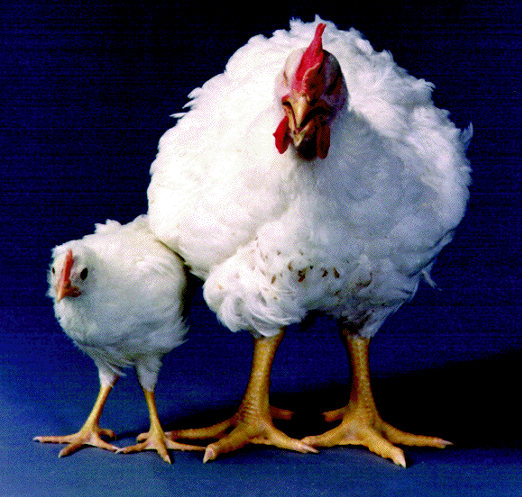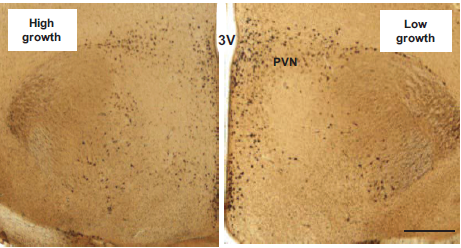Advanced intercross
Advanced intercross of a broiler and white leghorn
This line was discontinued in October 2021.

Summary
This line is an advanced intercross between a broiler chicken (Ross Breeders Ltd., Newbridge, Midlothian, UK) which is rapidly growing and has relatively poor reproduction and a white Leghorn which grows relatively slowly and has superior egg production1,2. The advanced intercross line has been used to identify and map Quantitative Trait Loci (QTL) that affect body weight1,3,4, the amount and distribution of body fat2 and bone mineral density5.

Utility
The advanced intercross line helped to identify how variation in certain genes can alter specific physiological pathways, which in turn lead to changes in growth and fat deposition. Research conducted with the advanced intercross line identified a locus on chromosome 4, which is responsible for up to a 19% difference in body weight in chickens at 12 weeks of age. Advanced intercross offspring can possess a high-growth or low-growth haplotype at the locus on chromosome 4, which is in the vicinity of the cholecystokinin receptor A (CCKAR) gene. Cholecystokinin and its receptor (CCKAR) play an important role in satiety feedback pathways between the brain and digestive organs. Cholecystokinin is a gut peptide that is elevated after a meal, leading to the reduction or cessation of feeding. High-growth advanced intercross chickens have lower expression of CCKAR in the brain, intestine, and pancreas, and do not reduce food intake after they have been exogenously administered with cholecystokinin6. They also have elevated agouti-related peptide expression, the major orexigenic peptide in the hypothalamus6. Therefore, the advanced intercross line can be used to study the effect of the CCKAR locus on growth.
Line origin
Chickens from a broiler line and a white Leghorn line were intercrossed to produce an F1 comprising 13 female and 11 male chickens, arranged into 13 pairings7. The offspring of these F1 families were intercrossed using a mating system to minimise inbreeding8. Each generation after the F1 was reproduced from 60 males and 60 females until generation 18. For full details see Sewalem et al (2002)1. Thereafter, the population was maintained based on maintaining heterozygosity at the CCKAR genomic locus using genetic markers6. It is likely that the population continues to segregate for other traits that differed between the founder lines including ocular dimensions that have been already studied7, but also growth and reproductive traits.
Publications
- Sewalem, A. et al. Mapping of quantitative trait loci for body weight at three, six, and nine weeks of age in a broiler layer cross. Poult. Sci. 81, 1775–1781 (2002).
- Ikeobi, C. O. N. et al. Quantitative trait loci affecting fatness in the chicken. Anim. Genet. 33, 428–435 (2002).
- Podisi, B. K., Knott, S. A., Burt, D. W. & Hocking, P. M. Comparative analysis of quantitative trait loci for body weight, growth rate and growth curve parameters from 3 to 72 weeks of age in female chickens of a broiler-layer cross. BMC Genet. 14, (2013).
- Podisi, B. K. et al. Overlap of quantitative trait loci for early growth rate, and for body weight and age at onset of sexual maturity in chickens. Reproduction 141, 381–389 (2011).
- Podisi, B. K., Knott, S. A., Dunn, I. C., Burt, D. W. & Hocking, P. M. British Poultry Science Bone mineral density QTL at sexual maturity and end of lay Bone mineral density QTL at sexual maturity and end of lay. Br. Poult. Sci. 53, 763–769 (2012).
- Dunn, I. C. et al. Decreased expression of the satiety signal receptor CCKAR is responsible for increased growth and body weight during the domestication of chickens. Am. J. Physiol. Endocrinol. Metab. 304, 909–921 (2013).
- Prashar, A. et al. Common determinants of body size and eye size in chickens from an advanced intercross line. Exp. Eye Res. 89, 42–48 (2009).
- Falconer, D. S. Replicated selection for body weight in mice. Genet. Res. 22, 291–321 (1973).


